Menus
- Flat twin, 1170 cm3, 125 hp at 7,750 rpm, 125 Nm at 6,500 rpm, 244 kilos with full tank, from € 16,400
- The world’s best-selling large displacement is as consistent as ever
- Discovery
- In the saddle
- Engine and transmission
- In the city
- On motorways and main roads
- On departmental
- Part-cycle
- Brakes
- Comfort and duo
- Consumption / autonomy
- Conclusion
Flat twin, 1170 cm3, 125 hp at 7,750 rpm, 125 Nm at 6,500 rpm, 244 kilos with full tank, from € 16,400
The world’s best-selling large displacement is as consistent as ever
It’s the price of success: taken individually, the BMW R 1200 GS is the best-selling large displacement in the world. Other side of the coin: in summer, at the top of an alpine pass, it is sometimes difficult to find your own GS, parked among hordes of other GS, with German, Italian, Spanish, Austrian plates … Well, at the same time, it’s not that easy to find your own GSX-R 1000 in a 24 Hours of Le Mans parking lot either….
The GS is not only a success: it is also a headache for other manufacturers, who struggle to exist in this segment, at least, as long as they try to copy it point for point, such Yamaha with the XTZ 1200 Super Tenere. We must therefore move away from the model if we want to break through a little, make more powerful, sportier and more road (Ducati Multistrada range) or less powerful and less expensive, on condition of capitalizing on a good identity (Honda Africa Twin ). But otherwise it’s hard.
The GS has become so much of a myth that it is entitled to its own variation for hipsters, the R nineT Urban GS … while, on the flip side, insurers are warning about its rising theft rate. GS’s theft has tripled over the past twelve months. Yes, that’s it too, success.
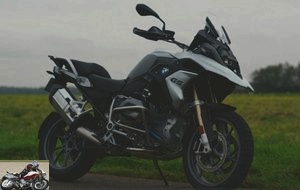
Small reminder of the saga: in 1979, BMW surprised everyone by launching the first large series twin-cylinder trail: the R 80 G / S. Small historical reminder: G for Gelande, S for Strasse, ie land and road. With its 50 horsepower, it sets new standards in the world of trails, until then dominated by 500 monos such as the Yamaha XT, which develops 32 horsepower. The first two years, the success was already decent, with more than 6,600 machines sold in all. The successes in the Dakar (4 victories between 1981 and 1985) help to build the myth and suddenly, BMW launched a Paris-Dakar version of its GS, with a 32-liter tank. Commercially, it did it fairly correctly: in 1987, more than 22,000 GS had already been sold. In 1987, the GS arrived in a 1000 version (60 hp), it also derived from a Dakar version (with 35-liter tank), while the R 65 GS with its 27-hp twin was overlooked (because of the ‘a new German regulation on young permits). In 1996, total sales of the first generation of this GS family amounted to 46,000 units. Not bad, but it is with the 4-valve Boxer engines that the sales figures will take off, to a whole new level. While it took almost 17 years to sell almost 50,000 copies, BMW only needed 13 more years to reach 500,000! Since then, the saga continues: 1100, 1150 (which reintroduced the Adventure version), 1200, 1200 double shaft, 1200 semi-liquid, each new evolution of the GS is at least as successful as the previous one..
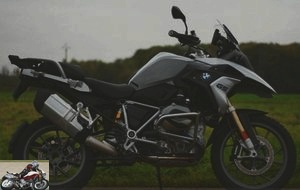
For 2017, BMW has changed its standard by making it pass the Euro 4 standard. The offer is even expanding, with Exclusive and Rally versions, which offer a more refined or sportier presentation, to choose from. We had the standard model for this test, however equipped with an optional low screen.
Discovery
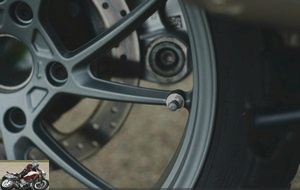
We know it so much by heart, this GS. BMW could have contented itself with passing it the new standard and basta, but the German manufacturer has gone a step further, with a combined work on aesthetics and technology. Suddenly, looking more closely, we see that the bubble has changed a little and that the front part is subtly different, with the fairing of the tank sides, the cover of the intake pipe, the cooling pipes and the radiator cover which have been redesigned. Colors and surface treatments are also different, white indicators are standard.
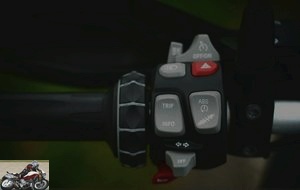
On the techno side, the R 1200 GS is also evolving: driving modes (Rain or Road) are standard, driving modes are emerging and ESA suspensions have a Dynamic mode, which operates in real time. Obviously, in a good premium machine, not everything is standard.
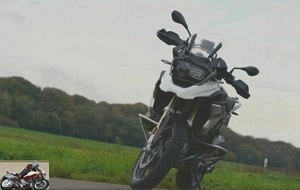
This test model was worth € 20,330, because it was equipped with the following options: Touring Pack (€ 1,625: suitcase support, GPS preparation, Pro on-board computer, ESA Dynamic, Keyless start), Dynamic Pack (€ 1,510: Pro shifter, mode of Pro piloting, LED indicators, LED lights), Comfort Pack (€ 565: handguards, chrome exhaust, heated grips) … We could have done even more techno by adding eCall, the automatic emergency call in the event of an accident.
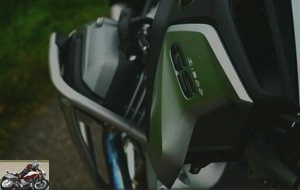
In the saddle
Here is what is called a beautiful piece. 244 kilos with full, 2.20 m long, 1.40 m high, 95 cm wide, a saddle placed at 850 mm (but which can vary from 800 to 920 mm depending on the options and configurations), the R 1200 GS is an imposing machine. Intimidating, too? This is what we think before settling on board, it being understood that jockey jigs will still have a little trouble dealing with such a machine, especially in town where stops follow starts and where to put your foot on the ground requires a little attention. Be careful, however, when maneuvering, the cylinder guards can hurt your shins..
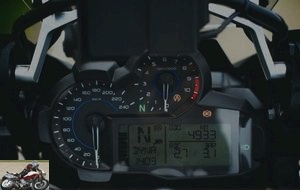
Once this first apprehension has passed, you find yourself well installed, with a natural driving position, quite upright, the legs not too bent. The instrumentation of board is complete, even if the support of GPS encroaches a little on the top of the tachometer. Otherwise, between the fuel gauge, the gear indicator engaged, the complete on-board computer, the heated grip indicator light, the dashboard is really super complete.
The keyless start is a little bonus. You press a button on the steering column and you’re done. The height of the screen is easily adjusted manually.
Engine and transmission
After its 2013 overhaul, which saw it switch to mixed air / water cooling, the good big 1170 cm3 flat twin was Euroquatrified and in the process, its power regime climbs by 50 rpm (to 7750 now). It has not lost in the change, retaining top performance: 125 hp and 125 Nm of torque, it is not ridiculous at all, even if in big trails, Ducati and KTM do not hesitate to display powers of 160 horses. It remains to be seen if people really need a trail that takes 250 km / h on the clock..
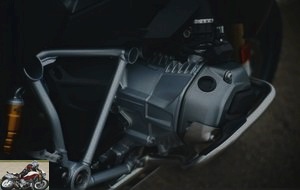
Quite talkative in the past (and moreover, too much in the eyes – even in the ears – of some), the Euro 4 flat twin today delivers a more subdued sound, less present at low revs. It is more pleasant for daily use as well as on long journeys.
The Pro shifter is an asset here too, especially in dynamic driving where "we freak out like the pilots!". If it is effective, there is however a small inertia in the feeling of the kinematic chain which means that we cannot forget that we are on the handlebars of a cardan machine..
In the city
Big size, big worries when making the interface, with the feeling that we will either stay tanked behind the cars, or tear everything with the cylinders protruding. Well no. Of course, when it’s really tight, the width of the handlebars and mirrors becomes handicapping, because it is at the level of the mirrors of vans and large SUVs; nevertheless, they have the merit of passing above those of normal cars.
Good turning radius, soft controls, mirrors that do not vibrate: all is well, otherwise, especially as the flat twin is, in this Euro 4 definition, even more flexible than it was in my memories of the versions previous.

On motorways and main roads
A GS is made to devour asphalt and this one does not derogate from its reputation. The low bubble is useless in this case and we take a little full face. To know for those who will buy the Rallye version. Otherwise, again, it’s all good. The saddle is soft, the suspensions are soft, the engine is … soft? Can we say "mellow" of an engine? Well yes, because it constantly surprises with this unique blend of sweetness, vigor, response and progressiveness. So yes, there are more powerful machines on the market, but once on the road and weighing everything, you tell yourself that the flat goes beautifully with the chassis of the GS and with the spirit of travel on a big trail.
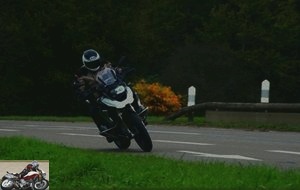
On long runs, the quieter engine and exhaust than in the past is a good thing. At 130 km / h on the last report, the flat-twin turns at a little less than 5000 rpm. The cruise control is a plus not to take a plum. And stability is obviously no problem.
On departmental
There is joy! This is what we start humming, on the handlebars, when we arrive on one of those little yellow lines that wind through Michelin maps. Because the GS, here more than elsewhere, is made for this environment. Between the very wide range of use of the engine (but which flourishes so much to be used on the torque, even when driving fast) and the chassis which shows a supernatural balance, the cocktail is really explosive.
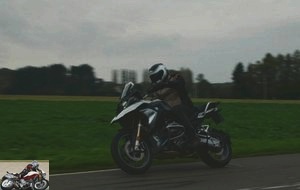
There, once in action, we look at this machine from a different perspective. Imposing, intimidating? No: easy, natural, obvious. The R 1200 GS loves the twisty, the bumps, the difficulties, the traps of the road, it loves that and its rider with it, because this is where it shows its superiority over all the other machines in this segment. Neutral on the braking phases, it enters the curves with the blink of an eye and tightens a trajectory with a movement of the nostril. Yes, we are talking about a machine weighing 250 kilos, as large (or almost) as a Smart and placed on suspensions which debate 190 mm in front and 200 mm behind. This motorcycle is magic.
Part-cycle
Classic and modern, the R 1200 GS combines the two. The classic is the traditional architecture of BMW: Telelever with central shock absorber, Paralever at the rear, nothing but proven. The tires are in classic dimensions here too: 120/70 x 19 in front, 170/60 x 17 behind. The plus here is the optional Dynamic ESA. Already, what is good is that depending on the mode chosen, the settings are done electronically and automatically, with real-time refinement depending on the driving style and the terrain encountered. Our advice: let it all be done in Dynamic mode.
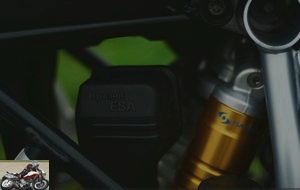
Brakes
Without going in excess (we have "only" 305 mm at the front), the braking of the GS is excellent. Biting present but not brutal, instantaneous power as soon as you press a little, the most lies in the Telelever which limits mass transfers. Braking has an "emergency" function with the brake light flashing, then the warnings which are activated, in the event of strong deceleration.
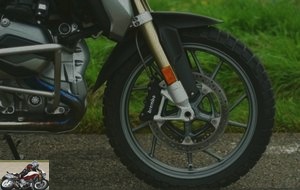
Comfort and duo
Impeccable, for the pilot as for the passenger. The saddles are wide and soft, the grab handles are well sized, the suspensions know how to adapt, the distance of the footrests does not mistreat the knees. This is undoubtedly one of the strengths of the machine.
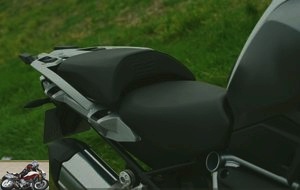
Consumption / autonomy
During this test, consumption fluctuated between 6 and 6.5 l / 100, or almost 300 kilometers of autonomy offered by the 20-liter tank. In absolute terms, it’s not bad at all. Those who want more will turn to the R 1200 GS Adventure, with its 30-liter fuel tank (and the extra weight).
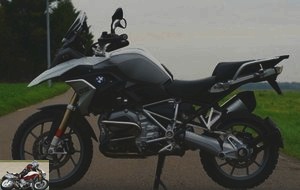
Conclusion
You only have to drive this R 1200 GS a bit to understand why it is so successful. It is not the most powerful of its kind, but horses are not everything and the character and availability of this engine, a little more flexible than in its "pre-Euro 4" versions, hit the mark in all circumstances. The R 1200 GS knows how to exhale a subtle feeling: that of well-being, that of always being on the right machine at the right time. For a large part of its owners, it is obvious that can only be replaced by another GS.
The Euro 4 version does not revolutionize the genre: a little more flexible, a little less noisy, even more techno, it is more successful than ever. But the GS is constantly evolving: for its 2018 vintage, it will be entitled to the fully digital TFT dashboard..
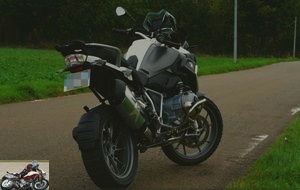
Strong points
- Absolute versatility
- Surreal balance given the weight and size
- Pleasant engine and still a little more flexible in E4
- State-of-the-art technological equipment
- Handling
- Ease of driving
- High level of comfort
Weak points
- There are everywhere !
- Really low bass bubble
- Bumping your legs into the crash bars when maneuvering
- Premium rate … and mandatory options
- Not too much for garden gnomes, though
The technical sheet of the BMW R1200GS
Test conditions
- Itinerary: A week of testing with daily trips in Ile de France and a walk in the Chevreuse valley
- Motorcycle mileage: 4,800 km
- Problem encountered: having had trouble finding it in a parking lot in La Defense, because there were 12 other GS parked around…
The competition: Ducati 1200 Multistrada, Honda Africa Twin, KTM 1290 Super Adventure S, Triumph 1200 Tiger, Yamaha XTZ 1200 Super Tenere
Related articles
-
3 cylinders in line, 1215 cm3, 141 hp at 9350 rpm, 122 Nm at 7600 rpm, 243 kilos dry, from € 19,950 Less weight and more techno for the big road trail…
-
Test Moto Morini Granpasso 1200
The big original trail Do you like long-distance trips and motorcycles that are both original and efficient? Moto Morini may have a model to seduce you:…
-
The way of Reason Teutonne Without going back to the genesis of the 30-year-old RT (Reise-Tourer) lineage, this road model sees its modern lineage dating…
-
Royal Enfield Classic Euro 4 test
4-T single cylinder, 499 cm3, 27.2 hp at 5,250 rpm, 41.3 Nm at 4,000 rpm, 195 kilos, € 5,985 A timeless machine with inimitable charm Welcome to the…
-
3 cylinders in line, 1215 cm3, 141 hp at 9350 rpm, 122 Nm at 7600 rpm, 248 kilos dry, from € 21,150 This variation of the Tiger 1200 family is intended…
-
Triumph Speed Triple 1200 RS motorcycle test
Madame More 3 cylinders in line, 1160 cm3, 180 hp at 10,750 rpm, 125 Nm at 9,000 rpm, 198 kg in running order, from € 17,500 Each time a new product is…
-
An essay by Damien Bertrand A new sports car with a flat engine twin is always an event awaited by lovers Bavarian twin cylinders. With this new oppus,…
-
Road bike 173 horses Presented in early 2010 as the synthesis of Honda know-how, both mechanically, qualitatively and technologically, the VFR 1200 did…
-
Mutation Gelande Sport Few machines can be proud of such a prestigious lineage as that of the German trail. At the top of high roads, drivable or not,…
-
The all-way golden eagle Stelvio: the highest road mountain pass in Italy at an altitude of 2,758 meters, with 84 bends … Can we find a more engaging…